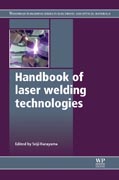
Laser welding is a rapidly developing and versatile technology which has found increasing applications in industry and manufacturing. It allows the precision welding of small and hard-to-reach areas, and is particularly suitable for operation under computer or robotic control. The Handbook of laser welding technologies reviews the latest developments in the field and how they can be used across a variety of applications.Part one provides an introduction to the fundamentals of laser welding before moving on to explore developments in established technologies including CO2 laser welding, disk laser welding and laser micro welding technology. Part two highlights laser welding technologies for various materials including aluminium and titanium alloys, plastics and glass. Part three focuses on developments in emerging laser welding technologies with chapters on the applications of robotics in laser welding and developments in the modelling and simulation of laser and hybrid laser welding. Finally, part four explores the applications of laser welding in the automotive, railway and shipbuilding industries.The Handbook of laser welding technologies is a technical resource for researchers and engineers using laser welding technologies, professionals requiring an understanding of laser welding techniques and academics interested in the field. Provides an introduction to the fundamentals of laser welding including characteristics, welding defects and evolution of laser weldingDiscusses developments in a number of techniques including disk, conduction and laser micro weldingFocusses on technologies for particular materials such as light metal alloys, plastics and glass INDICE: Part 1 Developments in established laser welding technologies: Introduction: Fundamentals of laser welding; Developments in CO2 laser welding; Developments in Nd:YAG laser welding; Developments in disk laser welding; Developments in pulsed and continuous wave laser welding technologies; Conduction laser welding; Developments in laser micro welding technology. Part 2 Laser welding technologies for various materials: Laser welding of light metal alloys: Aluminium and titanium alloys; Laser welding and brazing of dissimilar metals; Laser welding of plastics; Laser welding of glass; Defects formation mechanisms and preventive procedures in laser welding; Residual stress and distortion in laser welding. Part 3 Developments in emerging laser welding technologies: Applications of robotics in laser welding; Developments in beam scanning (remote) technologies and smart beam processing; Developments in twin-beam laser welding technology; Developments in multi-pass laser welding technology with filler wire; Developments in hybridisation and combined laser beam welding technologies; Developments in hybrid laser-arc welding technology; Developments in modelling and simulation of laser and hybrid laser welding. Part 4 Applications of laser welding: Applications of laser welding in the automotive industry; Applications of laser welding in the railway industry; Applications of laser welding in the shipbuilding industry.
- ISBN: 9780857092649
- Editorial: Woodhead Publishing
- Encuadernacion: Rústica
- Páginas: 688
- Fecha Publicación: 30/06/2016
- Nº Volúmenes: 1
- Idioma: Inglés
